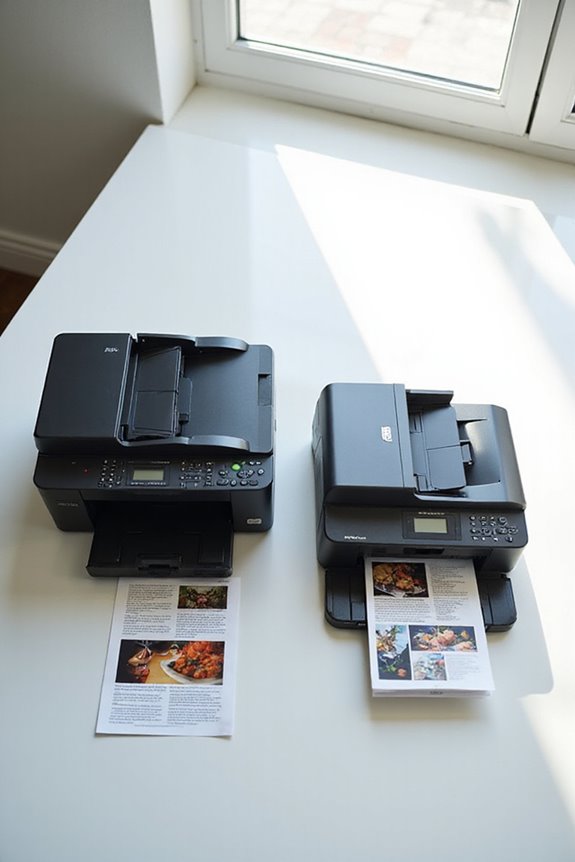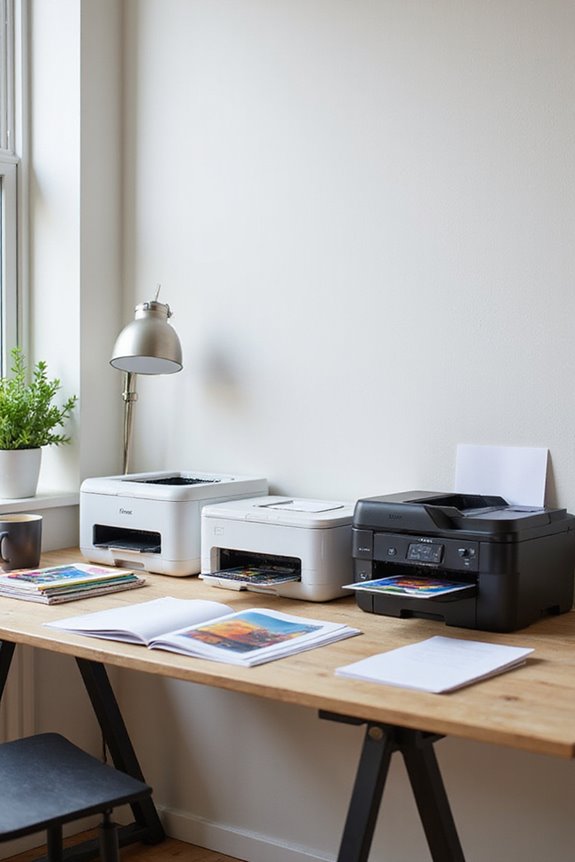When comparing all-in-one printers to single-function printers, the primary distinction lies in functionality. Single-function printers are designed exclusively for printing, making them ideal for users focused on that task alone. In contrast, all-in-one printers combine printing, scanning, copying, and sometimes faxing into a single device, offering versatility. While single-function printers are often less expensive upfront, all-in-one models can save space and resources. To understand how each printer type fits specific needs, let’s explore further.
Key Takeaways
- All-in-one printers (MFPs) combine printing, scanning, copying, and faxing, while single-function printers are exclusively for printing tasks.
- Single-function printers typically have a lower upfront cost, often under $100, compared to MFPs which range from $300 to $700.
- MFPs offer enhanced versatility and efficiency in workspaces, making them ideal for small businesses and home offices with diverse needs.
- Performance-wise, single-function printers excel in print quality for dedicated tasks, while MFPs optimize space and resources in busy environments.
- Long-term value varies; MFPs reduce the need for multiple devices, while single-function printers may incur lower maintenance costs over time.
Understanding Single-Function Printers
When it comes to printing needs, many people often overlook the advantages of single-function printers. These monofunction devices are designed solely for printing, making them ideal for homes and small offices where printing is the primary requirement. One of the key single function advantages is cost savings; they’re typically less expensive to purchase than multifunction printers. Additionally, their compact design allows for easier placement in limited spaces. However, single function limitations include the lack of scanning or copying capabilities, which may be necessary for some users. Ultimately, if your focus is primarily on printing, investing in a single-function printer can enhance productivity while minimizing maintenance and operational costs.
Exploring Multifunction Printers
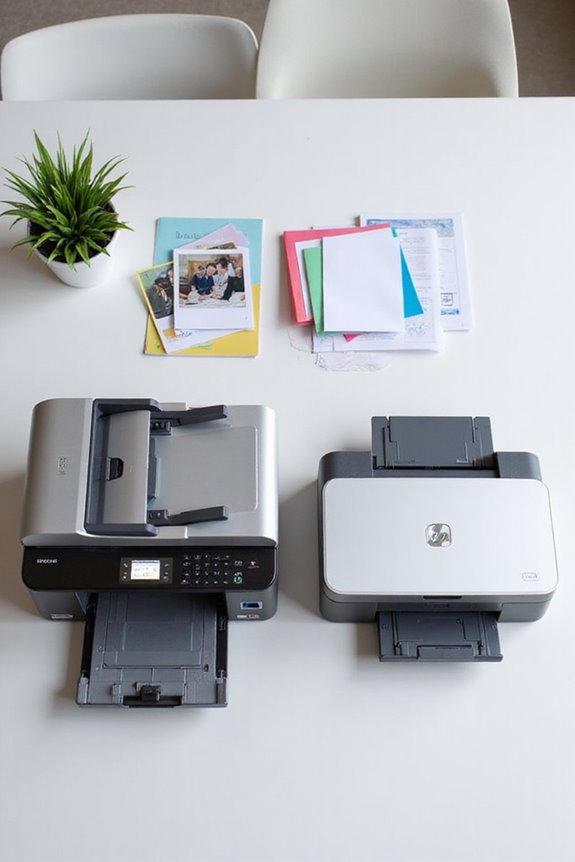
Multifunction printers have become increasingly popular in both home and office environments, thanks to their ability to consolidate several essential tasks into a single device. The multifunction printer advantages are numerous; they save space, reduce energy consumption, and lower overall costs. With a single unit, I can manage print, copy, scan, and fax functions seamlessly, enhancing workflow efficiency.
Moreover, the latest multifunction printer technologies, like tablet-like touchscreens and wireless printing capabilities, make operation intuitive and flexible. Features such as automatic document feeders streamline tasks, while advanced security measures protect sensitive information. Ultimately, these devices not only simplify document management but also support improved productivity, making them an invaluable asset for any workspace.
Key Differences in Functionality
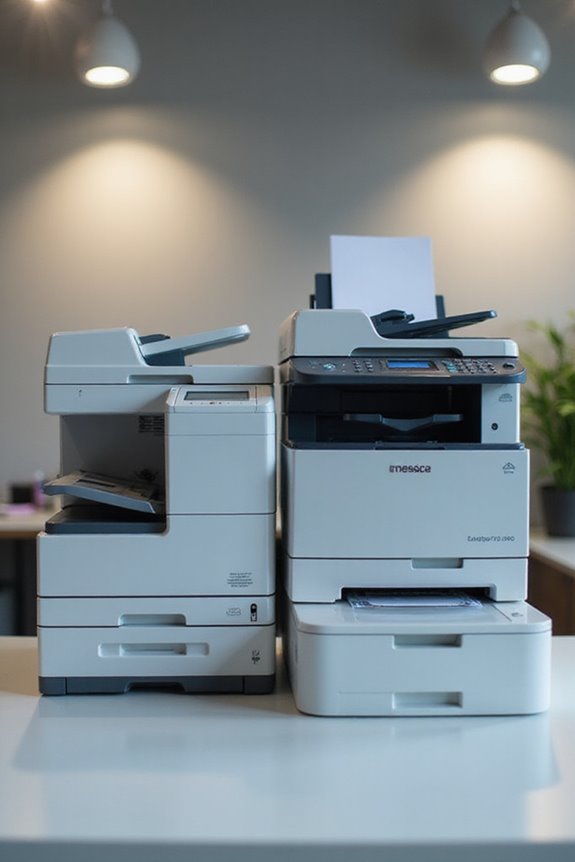
Although many people may think all printers serve the same purpose, the differences in functionality between all-in-one and single-function printers are quite significant. Single-function printers excel in print quality, delivering high-resolution prints that are ideal for users who prioritize clarity and detail. In contrast, all-in-one printers offer versatile capabilities that include scanning, copying, and even faxing. This multifunctionality is particularly beneficial for users with diverse needs, such as businesses that require efficient document management. However, user preferences play a vital role; those in fast-paced environments may prefer the efficiency of all-in-ones, while individuals with minimal printing needs might opt for the simplicity of single-function printers. Understanding these differences can help you choose the right device for your requirements.
Space Efficiency Comparison

In today’s fast-paced world, space efficiency is a essential consideration for both homes and offices. When comparing all-in-one and single-function printers, multifunction printers offer significant space-saving benefits. They consolidate printing, scanning, and copying into one device, dramatically reducing the overall device footprint. This is especially important for small offices or home workspaces where every inch counts.
While single-function printers may be more compact individually, they require additional devices for other tasks, leading to clutter and a larger overall footprint. By choosing a multifunction printer, you’ll minimize the need for multiple machines, resulting in fewer cables and a more organized workspace. Overall, multifunction printers are the ideal choice for maximizing space efficiency and maintaining a tidy environment.
Cost Considerations for Each Type
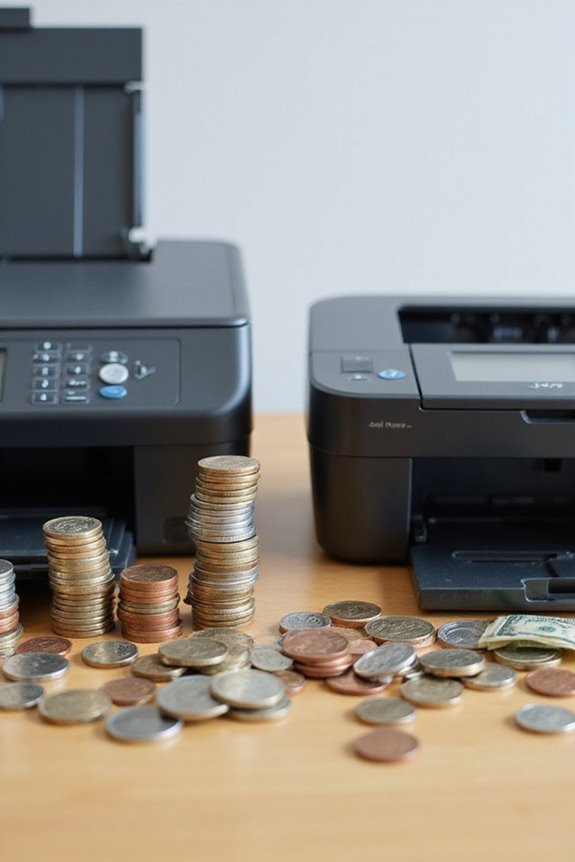
When evaluating cost considerations between all-in-one and single-function printers, it is crucial to look beyond the initial purchase price. Single-function printers usually have a lower upfront cost, often under $100, making them attractive for budget-conscious individuals or small offices. However, multifunction printers (MFPs) range from $300 to $700 but offer more features that can justify their price.
In my cost analysis, I find that MFPs can provide long-term savings through lower per-page costs and reduced maintenance for multiple functions. Still, if you only need printing, single-function models will likely be more economical. Ultimately, your budget considerations and printing needs will guide which type of printer is the best fit for you.
Target Audience for Single-Function Printers
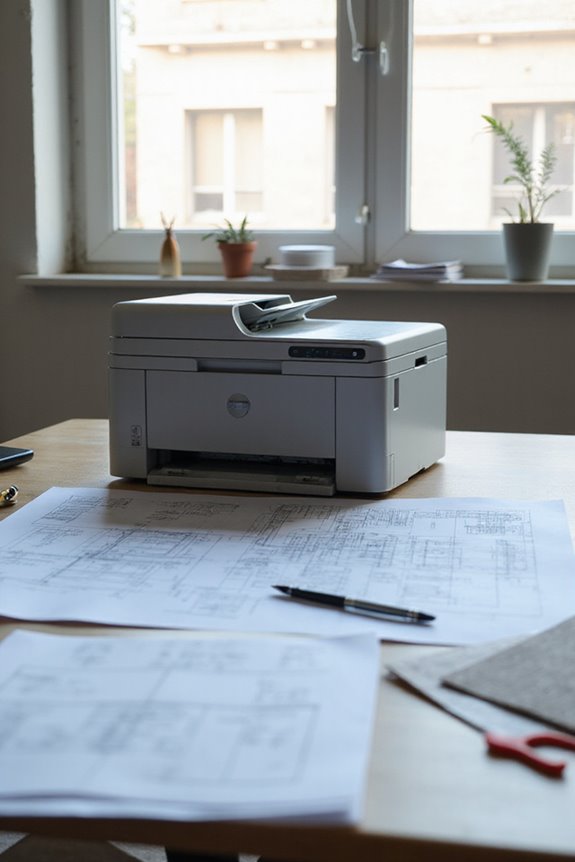
Many individuals and small businesses find single-function printers to be a perfect match for their basic printing needs. The target audience primarily includes first-time consumers and those in small to medium-sized businesses who value cost-effectiveness and simplicity. These users typically prioritize straightforward printing tasks without the desire for additional features like scanning or copying.
In the residential sector, single-function printers cater to home users who have basic printing requirements, while in commercial settings, they serve businesses that need reliable, high-quality prints. With options like inkjet and laser printers, these devices appeal to user preferences for compact designs and ease of use, making them an ideal choice for diverse environments, from offices to classrooms.
Who Benefits From Multifunction Printers?
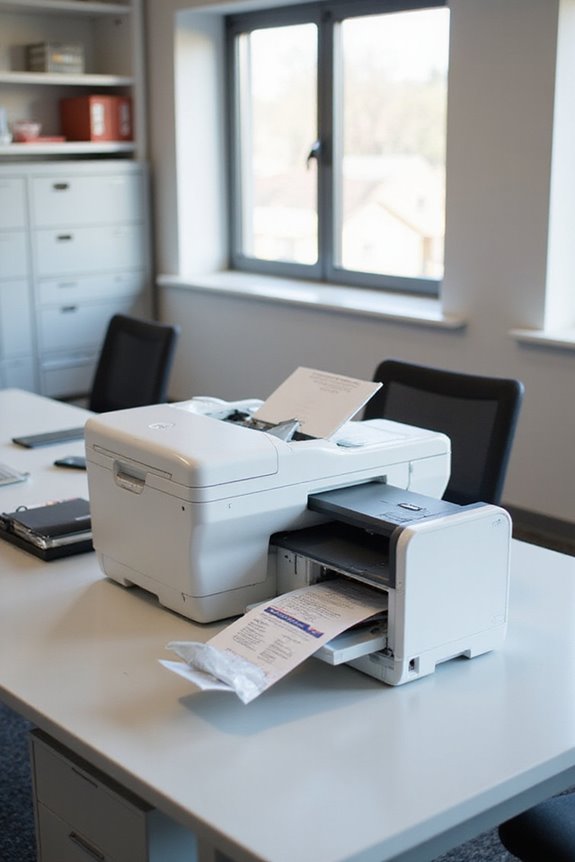
Multifunction printers provide significant advantages for various users. Small businesses often find them essential due to their space-saving design and cost-effectiveness. These devices consolidate printing, scanning, and copying into one unit, which simplifies workflows and reduces clutter.
Office workers also benefit from the centralized management of tasks, making it easier to collaborate and share resources. Remote workers enjoy the convenience of printing and scanning from their mobile devices, enhancing flexibility.
Additionally, home offices gain from the multifunction printer advantages, combining multiple functions into a compact solution. For environmentally conscious users, fewer devices mean lower energy consumption and reduced waste, contributing to a smaller carbon footprint. Overall, multifunction printers are effective small business solutions that enhance productivity.
Technical Capabilities of Each Printer Type

Understanding the technical capabilities of all-in-one and single-function printers can considerably influence your decision when choosing the right device.
All-in-one printers excel with high print resolutions, often reaching 600 x 2400 dpi, and they offer versatile connectivity options like Wi-Fi and USB. These features allow you to print, scan, and copy with ease, handling various paper sizes. In contrast, single-function printers are specialized for printing only, with models like the Epson Stylus Pro achieving up to 1440 dpi x 720 dpi. While they may offer fewer connectivity options, their speed and print volume can be advantageous for high-output needs. Ultimately, understanding these technical differences will guide you in selecting a printer that fits your specific requirements.
Impact on Operational Efficiency
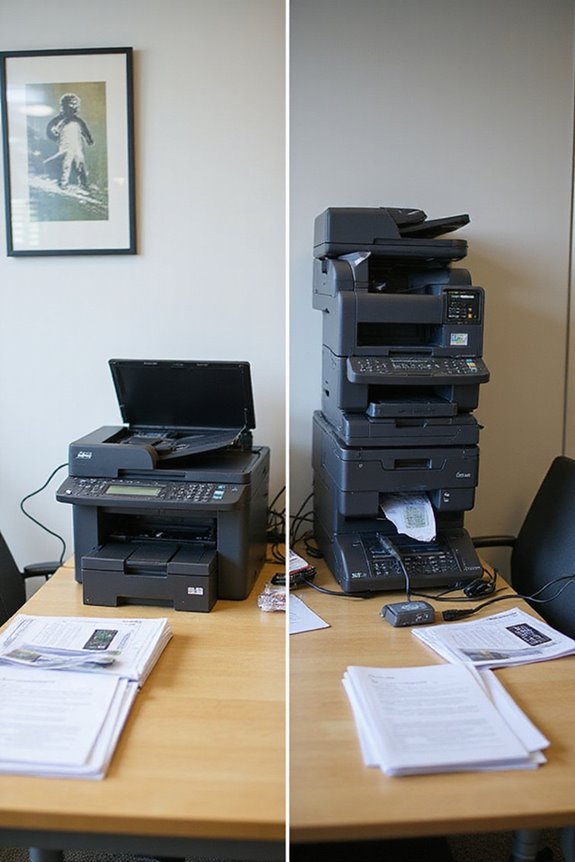
While selecting the right printer for your business, it’s essential to contemplate how each type affects operational efficiency. Multifunction printers (MFPs) greatly enhance operational workflows by consolidating multiple functions into a single device. This integration allows employees to perform various tasks without moving between separate machines, ultimately boosting productivity enhancement. In contrast, single-function printers necessitate additional devices for scanning or copying, which can disrupt workflow and reduce efficiency. Furthermore, MFPs simplify management and training processes, as staff only need to familiarize themselves with one device. By choosing an MFP, you’re not only streamlining operations but also optimizing space and resources, leading to better overall performance in your workplace.
Choosing the Right Printer for Your Needs

Selecting the right printer can greatly impact your workflow and productivity. When evaluating printer features, consider your specific tasks. If you need multifunctionality, an all-in-one printer may be ideal, especially in smaller spaces. However, if you only require printing capabilities, a single-function printer can save you money and maintenance effort.
Next, think about user preferences. Do you frequently print in color or need high-volume output? Inkjet printers excel in color, while laser models are efficient for bulk monochrome prints. Additionally, assess your budget—while all-in-one printers are pricier upfront, they can lead to long-term savings by combining multiple devices. Ultimately, the best choice aligns with your specific needs and work environment.
Frequently Asked Questions
Can Single-Function Printers Produce Better Print Quality Than Multifunction Printers?
Absolutely, I’ve found that single-function printers often excel in print quality compared to multifunction options. In my experience, this printer comparison highlights their ability to deliver sharper, more consistent results, especially for dedicated printing tasks.
Are There Eco-Friendly Options Available for Both Printer Types?
Yes, I’ve found eco-friendly options for both printer types. They often include eco-friendly features like energy efficiency and sustainable materials. It’s great knowing I can print while being kinder to the environment!
How Do Warranty Options Differ Between Single-Function and Multifunction Printers?
When diving into warranty comparisons, I found single-function printers offer basic coverage, while multifunction devices provide extra service options. It’s like comparing a simple cupcake to an extravagant multi-layer cake—both delicious, but one’s definitely more complex!
What Common Issues Do Users Face With Multifunction Printers?
I’ve faced common issues with multifunction printers, like frustrating paper jams that disrupt my workflow and ink smudging that ruins quality prints. It’s essential to keep these machines well-maintained to prevent such headaches.
Can I Network Single-Function Printers for Shared Use in an Office?
Absolutely, you can network single-function printers for shared use in an office. While the network setup might be a bit complex, ensuring printer compatibility across devices simplifies access and enhances overall efficiency.

